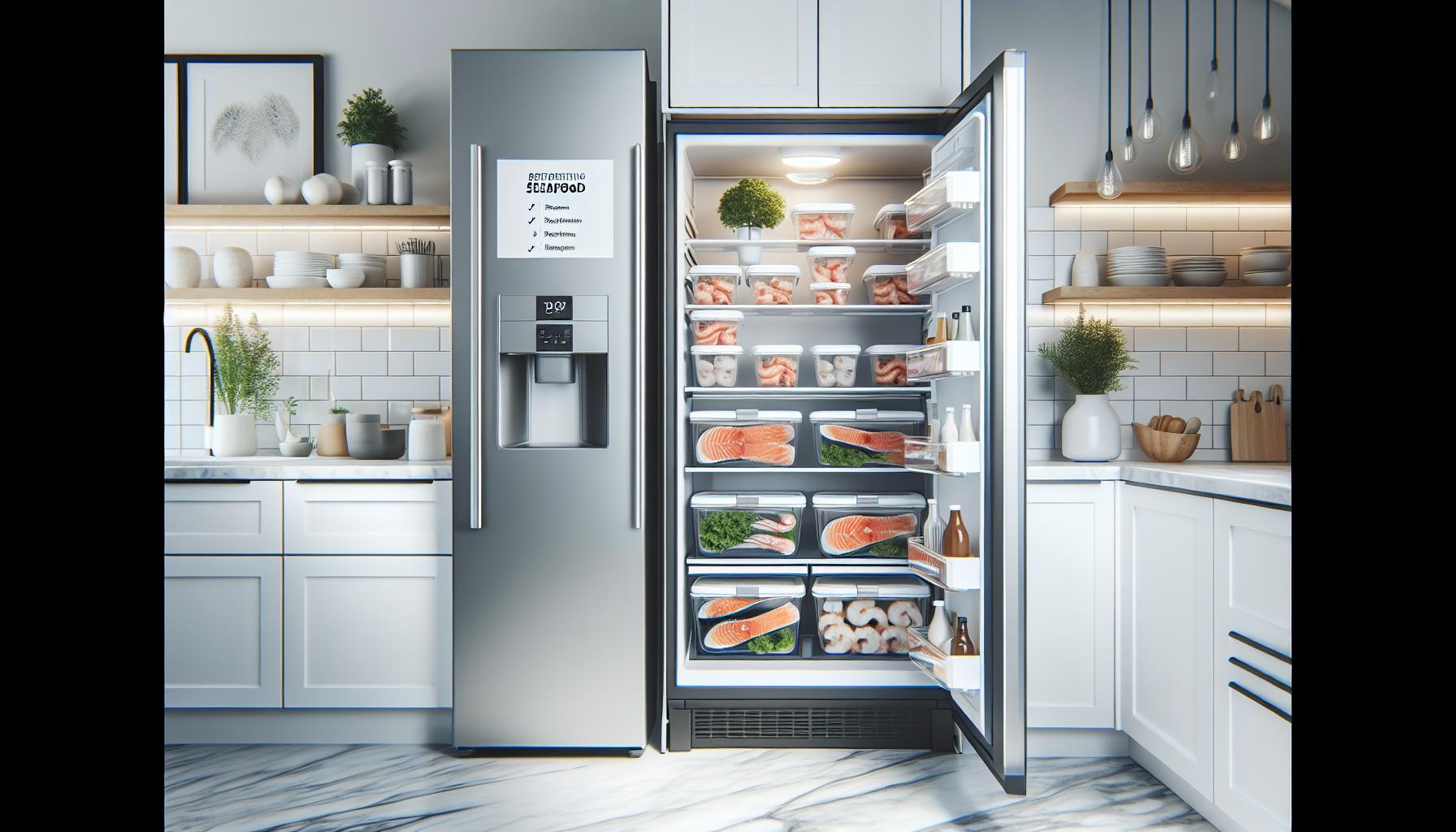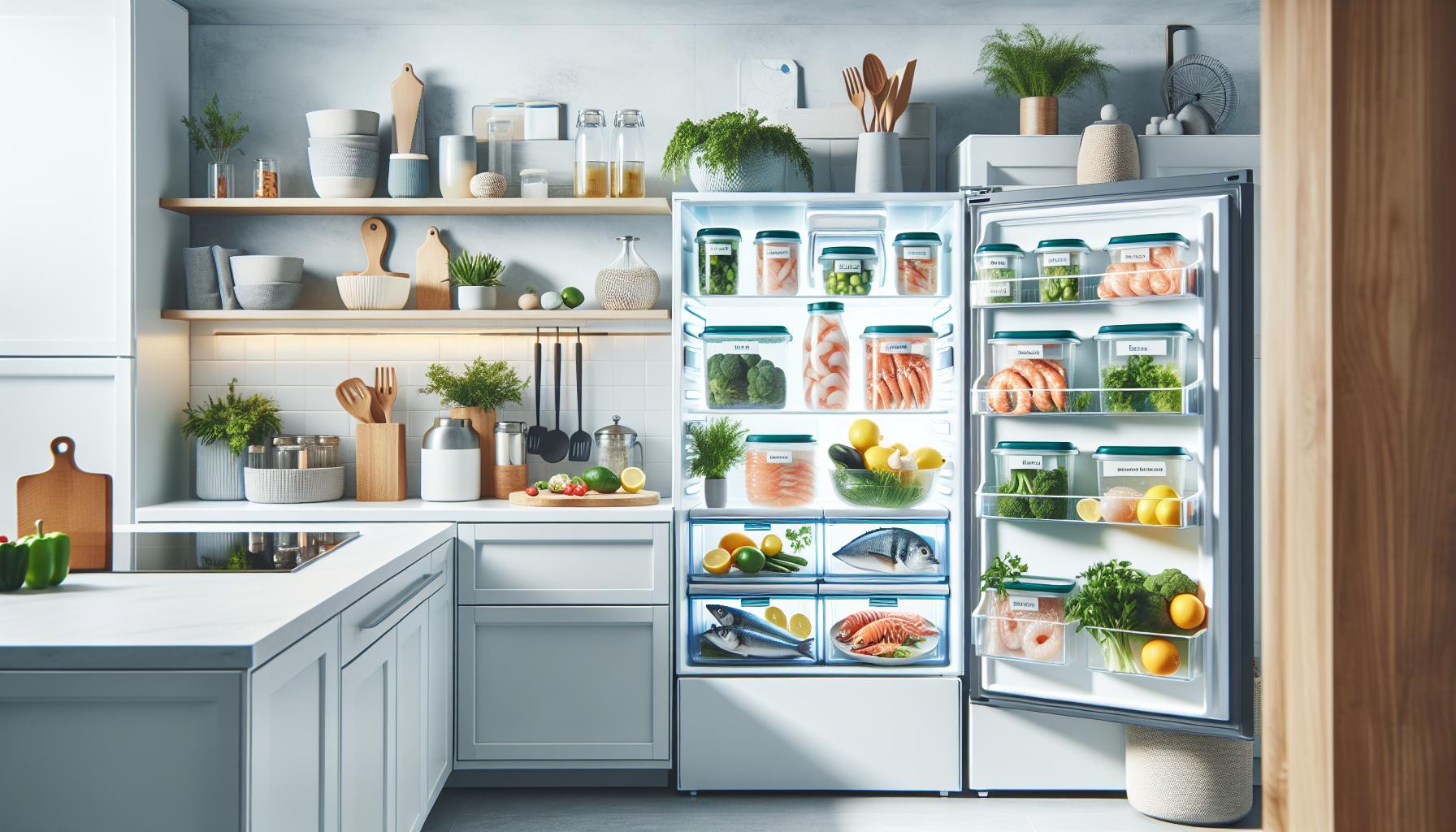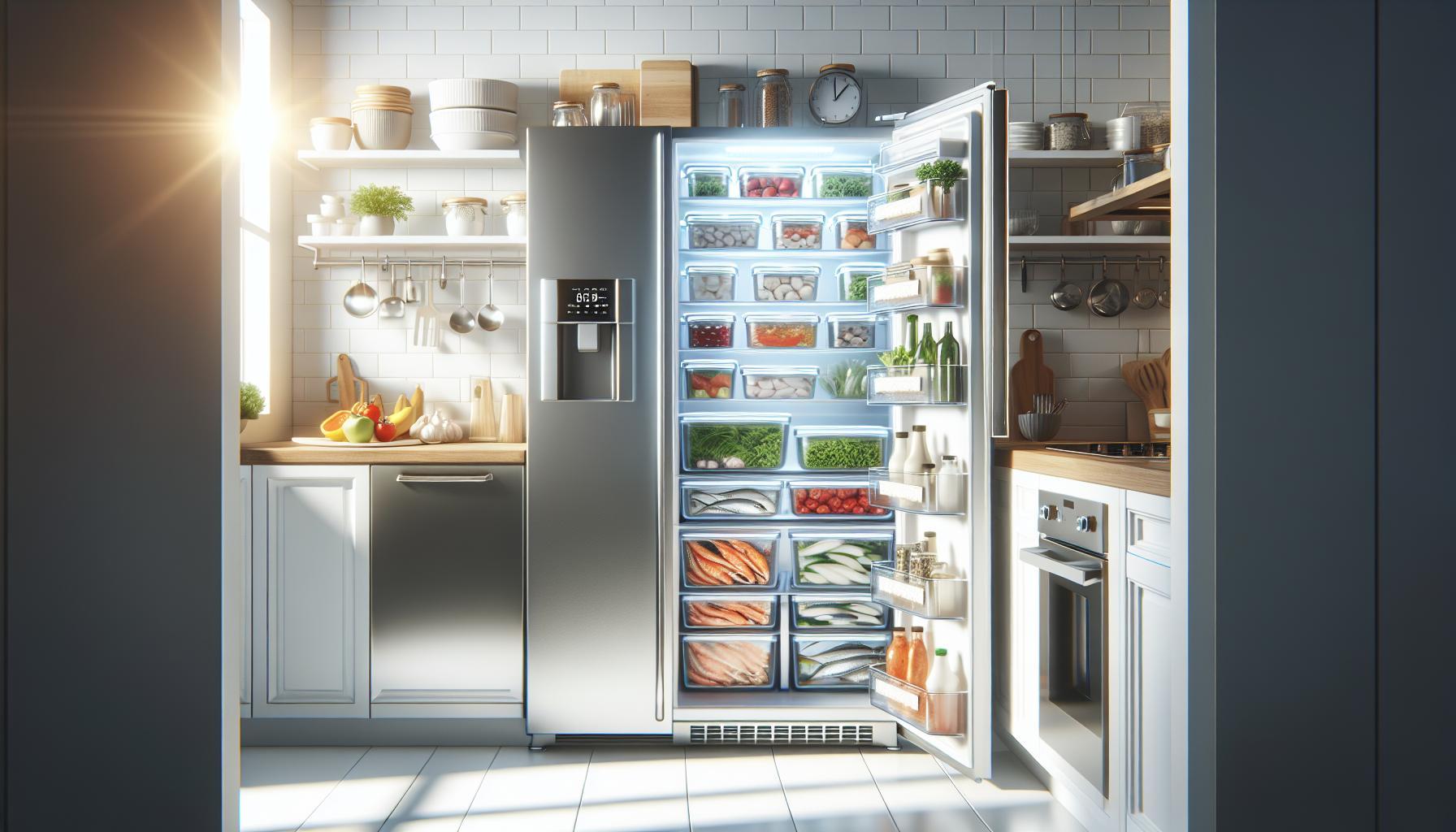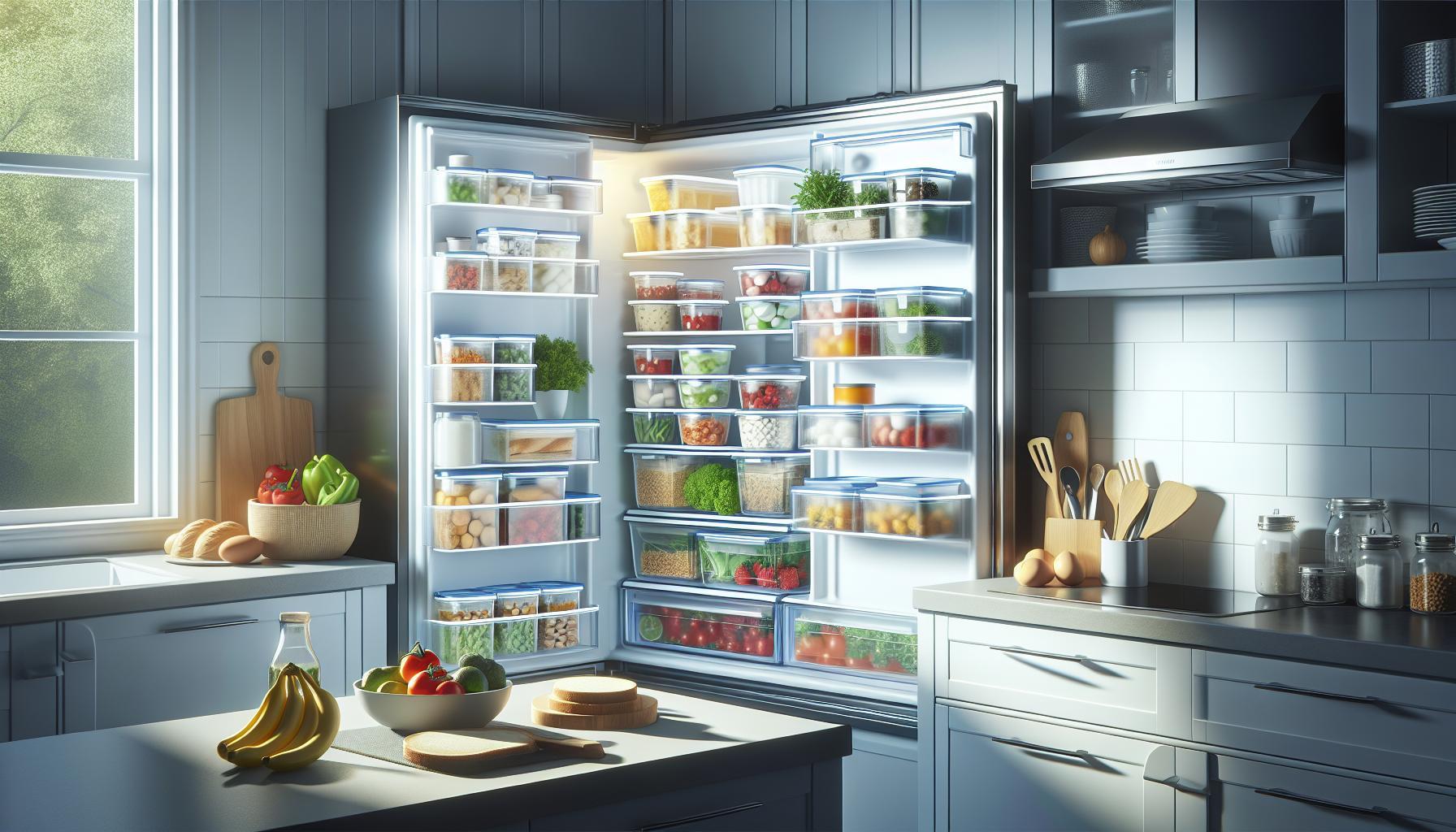Did you know that seafood can spoil faster than many other protein sources due to its delicate nature? When it comes to keeping your family safe and healthy, understanding how long seafood lasts in the fridge is crucial. Incorrect storage can lead to foodborne illnesses, which are a real concern for families.
This guide will explore vital timelines and best practices for storing seafood, ensuring you know exactly how to handle it with confidence. Whether you’re enjoying a delicious salmon fillet or a fresh shrimp cocktail, safeguarding your loved ones starts with informed choices. By the end of this article, you’ll have practical insights that empower you to keep your seafood fresh for as long as possible, making your culinary experiences both safe and enjoyable. Let’s dive in to ensure your meals are both delicious and safe!
How Long Can You Store Seafood in the Fridge?
The freshness of seafood can significantly impact both its taste and safety, making it crucial to know how long it can be safely stored in your refrigerator. Generally, raw fish and shellfish should be consumed within 1 to 2 days of purchase. When stored properly in the coldest part of your fridge, these highly perishable items can retain their quality for a short window, allowing you to enjoy their optimal flavor and texture.
Cooked seafood can extend this timeframe slightly, remaining safe for up to 3 to 4 days in the refrigerator. However, the quality may start to decline after the first couple of days. It’s important to keep seafood in a sealed container or tightly wrapped to prevent exposure to air, which can lead to spoilage. Additionally, ensuring that your refrigerator maintains a temperature of 32°F to 38°F (0°C to 3°C) is vital for maximizing the shelf life of seafood products.
Moreover, whole fish may last just a bit longer than fillets, lasting about 2 days in the fridge, while shellfish like clams, mussels, and oysters can be stored for up to 2 days as well. If you’re unsure whether seafood is still good to eat, always err on the side of caution: check for any off-smells, discoloration, or a slimy texture. Utilizing a fridge thermometer can help you ensure that your seafood storage conditions are adequately maintained, keeping your meals delicious and safe.
Best Practices for Refrigerating Seafood

The safety and quality of seafood can diminish quickly if not stored properly, making it essential to follow effective refrigeration techniques. Firstly, always store seafood in the coldest part of your refrigerator, typically at the back, away from the door, where temperatures fluctuate more. Aim for a refrigerator temperature between 32°F to 38°F (0°C to 3°C). For optimal preservation, place raw seafood in a shallow dish covered with ice or store it in the original packaging, wrapping it tightly if it’s been opened. This reduces exposure to air, helping to prevent spoilage.
When it comes to cooked seafood, storage practices can differ slightly. After cooking, allow seafood to cool completely before refrigerating. Store it in airtight containers or tightly wrapped in foil to maintain moisture and flavor. Even cooked seafood is best consumed within 3 to 4 days to ensure safety and quality. Label containers with the date of cooking, so you keep track of freshness easily.
It’s also wise to avoid placing seafood on the top shelf, where it might be exposed to warmer air. Instead, utilize a lower shelf or a dedicated seafood compartment if your refrigerator has one. If you see a package starting to leak, place it on a plate or in a bowl to avoid contamination of other foods. Regularly cleaning your refrigerator, especially spills, helps prevent bacterial growth, contributing to overall food safety.
Finally, always perform a sniff test or check for changes in texture when you’re about to use seafood. Signs such as off odors, discoloration, or a slimy texture are indicators that the seafood has spoiled and should not be consumed. By following these best practices, you can safeguard your family’s health while enjoying the delicious flavors that fresh seafood has to offer.
Signs Your Seafood Has Spoiled

When it comes to seafood, freshness is everything; eating spoiled seafood can lead to serious health risks. To protect yourself and your loved ones, it’s crucial to recognize the signs of spoilage before consuming any seafood. Fresh fish should have a mild smell, clear eyes, and shiny skin, while shellfish should be tightly closed when raw. When these characteristics change, it’s vital to act quickly.
Look for these key indicators of spoilage:
- Unpleasant Odor: Fresh seafood typically has a clean, ocean-like smell. If you notice a strong, fishy, or ammonia-like odor, it’s time to discard the seafood.
- Discoloration: Fresh fish should be vibrant and properly colored. If you see dullness or yellowing, it is a strong signal that the seafood has aged.
- Texture Changes: Good seafood should be firm to the touch. If it feels slimy or sticky, or if it has a mushy texture, it may have gone bad.
- Shellfish Conditions: For shellfish, check that they are tightly closed; any open shells indicate that the shellfish is dead and likely spoiled. Likewise, any shells that don’t close when tapped should be discarded.
- Floating in Liquid: Raw seafood may sometimes be stored in liquid; however, if it appears to be floating or is submerged in a watery or viscous solution, it may indicate spoilage.
Keeping a close eye on these characteristics can help you make informed decisions about your seafood. Regularly checking your refrigerator and promptly consuming seafood within 1-2 days of purchase for raw varieties or 3-4 days for cooked seafood can significantly reduce the risk of spoilage. Always trust your senses, and when in doubt, it’s safer to throw it out. Remember, taking these precautions ensures that you enjoy the nutritious benefits of seafood without compromising your health.
Tips for Extending Seafood Freshness

To maximize the freshness and safety of seafood, a few practical strategies can significantly extend its shelf life. Firstly, proper refrigeration is crucial. Make sure your fridge is set to a consistent temperature of 32°F to 39°F (0°C to 4°C), ideally around 34°F (1°C), to create an optimal environment for storing seafood. If possible, place raw seafood on the bottom shelf where it is coldest, and store it in a leak-proof container to prevent juices from contaminating other foods.
One effective method to maintain freshness is to store seafood on ice. If you’re able to, keep seafood on a bed of ice within a container. As the ice melts, drain the water to prevent the seafood from soaking in it, which can accelerate spoilage. Additionally, wrapping seafood tightly in plastic wrap or aluminum foil can help minimize exposure to air, which leads to oxidation and deterioration.
Another helpful tip is to keep seafood away from strong-smelling foods within the refrigerator. Seafood can easily absorb odors from items like onions or garlic, which can alter its flavor. To further preserve freshness, consume seafood within specific time frames: raw fish should be consumed within 1-2 days, while cooked seafood can last 3-4 days in the fridge. For longer storage, consider freezing seafood as soon as possible, ideally while it’s still fresh, and ensure it’s well-wrapped to prevent freezer burn.
Engaging with seafood within correct timeframes and conditions will not only enhance its taste and quality but will also protect your health. Remember, following these simple tips can make a substantial difference in how long your seafood lasts and the enjoyment it brings to your meals.
Proper Seafood Storage Techniques
To enjoy seafood at its best and maintain safety, employing proper storage techniques is essential. When considering how to store seafood, remember that seafood is highly perishable; therefore, handling it with care is crucial. The first step in effective seafood storage is ensuring that it’s kept at the correct temperature. A refrigerator should ideally be set between 32°F to 39°F (0°C to 4°C), with a target of about 34°F (1°C). This temperature range not only slows bacterial growth but also helps maintain the seafood’s texture and flavor.
When preparing to store seafood, always use leak-proof containers. This prevents any juices from contaminating other foods in the refrigerator, which is especially important if you’re storing items like raw fish or shellfish. Additionally, another excellent method for preserving freshness is to place seafood on a layer of ice when storing it. If using this technique, it’s important to drain any melted water regularly. Keeping seafood dry helps reduce spoilage while maintaining optimal freshness.
It’s also a good practice to wrap seafood tightly in plastic wrap or aluminum foil. This minimizes exposure to air, which can cause oxidation and reduce quality over time. Notably, seafood has varying shelf lives: raw fish should ideally be consumed within 1-2 days, while cooked seafood can last up to 3-4 days. For long-term storage, freezing is the best option. Ensure seafood is wrapped securely and label it with the date before placing it in the freezer to avoid freezer burn.
Incorporating these storage strategies will not only help maximize the lifespan of your seafood but also ensure that it remains delicious and safe for consumption. Remember, maintaining the integrity of your seafood goes hand-in-hand with the enjoyment of your meals and the safety of those you love.
Different Types of Seafood and Their Shelf Life
Different types of seafood have unique storage requirements and shelf lives, which are paramount in ensuring safety and quality. Fresh seafood varies significantly in how long it remains safe to consume. For example, raw fish and shellfish are highly perishable and should be eaten within 1-2 days of purchase. Fish such as salmon and tuna, which are often more costly, should be prioritized for consumption within this timeframe for the best flavor and texture.
Cooking seafood can extend its shelf life. Once cooked, seafood can generally last in the refrigerator for 3-4 days. For instance, a leftover shrimp pasta dish or baked fish can still be enjoyable and safe for a few days after cooking if stored correctly. Nonetheless, be vigilant for any off-smells or changes in texture as indicators of spoilage.
Here is a summary of various seafood types and their general shelf lives in the refrigerator:
| Type of Seafood | Raw Shelf Life | Cooked Shelf Life |
|---|---|---|
| Fish (e.g., salmon, tuna) | 1-2 days | 3-4 days |
| Shrimp | 1-2 days | 3-4 days |
| Clams, Oysters, and Mussels | 1-2 days | 3-4 days |
| Crab | 1-2 days | 3-4 days |
| Cooked Lobster | N/A | 3-4 days |
Aside from specific types of seafood, age at purchase also affects shelf life. Always check for the purchase date and consider using seafood soon after buying it. To prolong freshness, store your seafood in the coldest part of your refrigerator, ideally surrounded by ice if possible. By being mindful of these guidelines, you can enjoy delicious seafood while minimizing health risks associated with spoilage.
Understanding Seafood Expiration Dates
is crucial for ensuring safety in the kitchen and minimizing food waste. Seafood is one of the most perishable food categories, and knowing how to interpret the dates on packaging can help you make informed decisions. Often, sellers use terms like “sell by,” “use by,” or “best before” to indicate the period during which the seafood will maintain its best quality.
Sell by dates are primarily for retailers, indicating when the store should rotate stock. This means that seafood sold near its sell-by date may still be safe to consume for a short time after purchase, provided it is stored correctly. In contrast, use by and best before dates are more critical for consumers, indicating the last date the product will be at its highest quality. After a use-by date, the safety of the seafood cannot be guaranteed, and it should be discarded.
Cooking your seafood can also create some leeway with expiration dates. Once seafood has been cooked, it can be safely refrigerated for an additional 3-4 days. For leftovers, always store them in airtight containers and reheat them thoroughly before consumption. Additionally, if you freeze seafood prior to the use-by date, it can extend its longevity significantly, allowing you to enjoy it even weeks or months later when thawed properly.
To keep seafood safe, always trust your senses: if it smells fishy or has a slimy texture, it is best to err on the side of caution and dispose of it. Always prioritize freshness by purchasing from reputable sources and monitoring seafood consumption closely to safeguard your family’s health.
Safe Seafood Thawing Methods
Thawing seafood properly is critical for maintaining its quality and safety. Incorrect thawing can result in a decline in texture and flavor, as well as create an environment for harmful bacteria to thrive. For instance, you should never thaw seafood at room temperature, as this can allow the outer layer to warm up while the inside remains frozen. Bacteria multiply quickly in temperatures between 40°F and 140°F, making this practice dangerous. Instead, consider the following safe methods for thawing seafood.
Thawing Methods
- Refrigerator Thawing: This is the safest and most recommended method. Transfer the seafood from the freezer to the refrigerator and allow it to thaw slowly over the course of several hours or overnight, depending on the size and type of the seafood. This method keeps seafood at a safe temperature (below 40°F) throughout the process.
- Cold Water Thawing: If you need to thaw seafood more quickly, place it in a sealed plastic bag and submerge it in cold water. Change the water every 30 minutes to ensure it stays cold. This method should allow seafood to thaw within 1-2 hours, depending on the size.
- Microwave Thawing: Use your microwave’s defrost setting to thaw seafood, but be cautious, as some parts may start cooking during this process. After microwaving, cook the seafood immediately to guarantee it remains safe.
Remember that once seafood has been thawed using cold water or microwave methods, it should not be refrozen unless it has been cooked first. The refrigerator method offers the safest approach if you plan to keep the seafood for a longer period before cooking.
By adhering to these thawing practices, you can ensure that your seafood remains fresh, delicious, and safe for consumption. Always prioritize safety to protect your health and the well-being of your family.
Health Risks of Eating Spoiled Seafood
Eating spoiled seafood poses serious health risks that can lead to foodborne illnesses, which are often more than just an unpleasant experience. Seafood is particularly susceptible to spoilage due to its high moisture content and nutrient-rich environment, making it a breeding ground for harmful bacteria and pathogens if not stored properly. The most common culprits include Vibrio, Salmonella, and Listeria, which can cause symptoms ranging from mild gastrointestinal discomfort to severe conditions requiring hospitalization.
When seafood spoils, it can develop an off-putting odor, change in color, and a slimy texture-all signs that it should not be consumed. Consuming spoiled seafood can lead to symptoms such as nausea, vomiting, diarrhea, abdominal cramps, and fever. In some cases, particularly for vulnerable populations including pregnant women, young children, the elderly, and individuals with weakened immune systems, these infections can escalate to life-threatening complications. Therefore, it is crucial to adhere to proper storage guidelines to minimize these risks.
To help safeguard against spoilage, ensure seafood is stored at temperatures below 40°F (4°C) and consumed within 1-2 days if kept in the refrigerator. If you’re unable to consume it within this timeframe, freezing is a safe option that can extend its shelf life significantly. When thawing seafood, always utilize safe methods such as refrigerator thawing or cold water thawing to maintain quality and prevent bacterial growth.
Regularly checking for signs of spoilage not only protects your health but also prevents food waste, ensuring that meals remain enjoyable and safe. Always prioritize freshness and practice diligence in handling and storing seafood; the health of you and your family depends on it.
How to Safely Use Leftover Seafood
Using leftover seafood wisely can extend its lifespan and reduce food waste, all while ensuring your meals remain safe and delicious. When you refrigerate cooked seafood, it’s best to consume it within 1-2 days to maintain quality and safety. If you have leftover seafood dishes such as pasta with shrimp or a seafood salad, promptly refrigerate them in airtight containers to minimize exposure to airborne bacteria.
When you’re ready to use your leftover seafood, inspect it carefully. Look for any signs of spoilage, such as off odors, sliminess, or discoloration. If everything looks and smells normal, reheat the seafood thoroughly to an internal temperature of 165°F (74°C) before consuming. This reheating process is not only a safety measure but can also enhance the flavors of leftover dishes if done mindfully.
To creatively repurpose leftover seafood, consider integrating it into new recipes. Some practical ideas include adding shrimp or crab to a vegetable stir-fry, mixing fish into a chowder, or using it in a seafood quesadilla. These options not only save food but also provide an exciting twist to your meals. Remember, when combining leftover seafood with other ingredients, ensure that you store the new dish properly, maintaining the same guidelines of refrigeration for any new contents.
Lastly, if you find yourself with seafood leftovers that cannot be consumed within the safe timeframe, don’t hesitate to freeze them for future use. By wrapping the seafood tightly in plastic wrap or aluminum foil, or placing it in a freezer-safe container, you can keep it for up to three months in the freezer without compromising its quality. This step not only helps in meal planning but also allows you to enjoy your favorite seafood dishes at your convenience, all while adhering to safe food handling practices.
When to Freeze Seafood for Long-Term Storage
To ensure that seafood remains safe and flavorful for later enjoyment, it’s essential to know when to freeze it for long-term storage. Freezing seafood effectively halts bacterial growth and can preserve the quality of your seafood for months. If you find yourself with unexpected leftovers or purchased extra seafood, freezing can be a practical and safe option.
For optimal results, seafood should be frozen as soon as possible, ideally the same day it is cooked or purchased. Fresh, raw seafood can be stored in the freezer for up to six months, while cooked seafood generally lasts around three months. To guarantee maximum freshness, wrap raw fish tightly in plastic wrap or aluminum foil, or use vacuum-sealed bags to remove air. This helps prevent freezer burn, which can affect both the texture and flavor of your seafood.
When you are ready to freeze seafood, consider categorizing it based on type and intended use, such as dividing fish, shellfish, and cooked dishes into separate containers. Label each with the date and contents for easy identification later. For example:
| Type of Seafood | Storage Duration (Freezer) |
|---|---|
| Raw fish | 3-6 months |
| Cooked seafood | 2-3 months |
| Shellfish (raw) | 3 months |
| Shellfish (cooked) | 2 months |
To maintain food safety, never freeze seafood that has been left out at room temperature for over two hours. Instead, directly place it in the freezer after prepping. When thawing frozen seafood, do so safely by transferring it to the refrigerator and allowing it to thaw overnight, or by using the microwave if you plan to cook it immediately. This approach minimizes the risk of bacteria growth and enhances the overall eating experience. By understanding the ideal times and methods for freezing seafood, you can safeguard your family’s health while also reducing food waste.
Frequently asked questions
Q: How can I tell if seafood is safe to eat after being in the fridge?
A: To determine seafood safety, check for signs like a sour odor, dull color, and slimy texture. Fresh seafood should smell mild, look vibrant, and feel firm. If in doubt, it’s safer to discard it to avoid health risks. For more details, refer to the “Signs Your Seafood Has Spoiled” section.
Q: What is the best way to store seafood in the fridge?
A: Store seafood in the coldest part of your fridge (usually at the bottom) in its original packaging or a sealed container. Keep it on a plate to catch drips and cover it with plastic wrap for added protection. For enhancing freshness, see “Proper Seafood Storage Techniques.”
Q: Is it better to freeze seafood or keep it in the fridge?
A: Freezing seafood is best for long-term storage beyond a couple of days. If you won’t consume it within two days, wrap it tightly to prevent freezer burn and store it in the freezer. Check “When to Freeze Seafood for Long-Term Storage” for more specific timelines.
Q: How long can I keep cooked seafood in the fridge?
A: Cooked seafood can typically last 3 to 4 days in the fridge when stored properly in an airtight container. Always check for off odors or discoloration before eating. For more information, see “How Long Can You Store Seafood in the Fridge?”
Q: What should I do if I’ve accidentally thawed seafood in room temperature?
A: If seafood has been thawed at room temperature for more than two hours, it’s safer to discard it. Bacteria grow rapidly at room temperature, posing health risks. Refer to “Safe Seafood Thawing Methods” for proper thawing techniques.
Q: Can I use leftover seafood in new recipes?
A: Yes, leftover seafood can be used in various dishes like salads or casseroles within 3 to 4 days of cooking. Ensure it has been stored correctly and check for freshness before usage. See “How to Safely Use Leftover Seafood” for more tips.
Q: What types of seafood spoil the fastest?
A: Shellfish like oysters and clams spoil faster due to their high moisture content. Fish also has a shorter shelf life compared to other proteins. For detailed information on specific types and their corresponding shelf lives, check “Different Types of Seafood and Their Shelf Life.”
Q: How can I extend the freshness of seafood in the fridge?
A: Extend seafood freshness by placing it in a sealed container, using ice packs, or keeping it submerged in ice. Ensure that the fridge temperature is consistently below 40°F (4°C). For more tips, refer to “Tips for Extending Seafood Freshness.”
To Wrap It Up
To safeguard your family’s health, remember that seafood is best consumed within 1-2 days when stored in the fridge. Keeping track of these timeframes can prevent foodborne illnesses and ensure your meals are both delicious and safe. Don’t hesitate to explore more about food safety and proper storage practices by checking out our guides on “Food Storage Tips” and “Understanding Expiration Dates.”
Act now-make sure you’re storing your seafood properly and keeping a close eye on those dates. If you have any questions or want to share your own tips on seafood storage, drop a comment below! For more expert insights, consider signing up for our newsletter, where you’ll get the latest on food safety and health directly to your inbox. Let’s keep your kitchen safe and your family healthy, one meal at a time!





